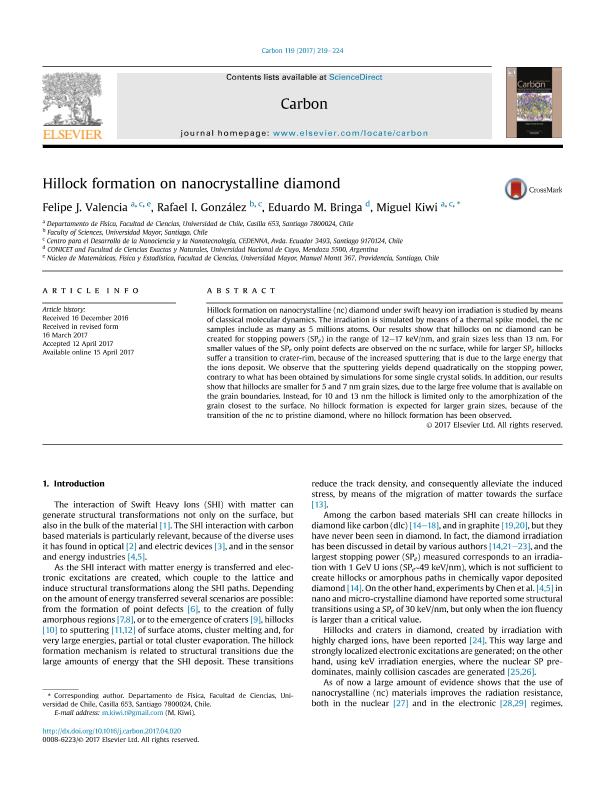Mostrar el registro sencillo del ítem
dc.contributor.author
Valencia, Felipe J.
dc.contributor.author
González, Rafael I.
dc.contributor.author
Bringa, Eduardo Marcial

dc.contributor.author
Kiwi, Miguel

dc.date.available
2018-01-03T21:45:06Z
dc.date.issued
2017-04
dc.identifier.citation
Valencia, Felipe J.; Kiwi, Miguel; Bringa, Eduardo Marcial; González, Rafael I.; Hillock formation on nanocrystalline diamond; Elsevier; Carbon; 119; 4-2017; 219-224
dc.identifier.issn
0008-6223
dc.identifier.uri
http://hdl.handle.net/11336/32250
dc.description.abstract
Hillock formation on nanocrystalline (nc) diamond under swift heavy ion irradiation is studied by means of classical molecular dynamics. The irradiation is simulated by means of a thermal spike model, the nc samples include as many as 5 millions atoms. Our results show that hillocks on nc diamond can be created for stopping powers (SPe) in the range of 12–17 keV/nm, and grain sizes less than 13 nm. For smaller values of the SPe only point defects are observed on the nc surface, while for larger SPe hillocks suffer a transition to crater-rim, because of the increased sputtering that is due to the large energy that the ions deposit. We observe that the sputtering yields depend quadratically on the stopping power, contrary to what has been obtained by simulations for some single crystal solids. In addition, our results show that hillocks are smaller for 5 and 7 nm grain sizes, due to the large free volume that is available on the grain boundaries. Instead, for 10 and 13 nm the hillock is limited only to the amorphization of the grain closest to the surface. No hillock formation is expected for larger grain sizes, because of the transition of the nc to pristine diamond, where no hillock formation has been observed.
dc.format
application/pdf
dc.language.iso
eng
dc.publisher
Elsevier

dc.rights
info:eu-repo/semantics/openAccess
dc.rights.uri
https://creativecommons.org/licenses/by-nc-nd/2.5/ar/
dc.subject
Diamond
dc.subject
Irradiation
dc.subject
Thermal Spike
dc.subject.classification
Astronomía

dc.subject.classification
Ciencias Físicas

dc.subject.classification
CIENCIAS NATURALES Y EXACTAS

dc.title
Hillock formation on nanocrystalline diamond
dc.type
info:eu-repo/semantics/article
dc.type
info:ar-repo/semantics/artículo
dc.type
info:eu-repo/semantics/publishedVersion
dc.date.updated
2017-12-19T18:36:30Z
dc.journal.volume
119
dc.journal.pagination
219-224
dc.journal.pais
Países Bajos

dc.journal.ciudad
Ámsterdam
dc.description.fil
Fil: Valencia, Felipe J.. Universidad Mayor. Facultad de Ciencias. Núcleo de Matemáticas, Física y Estadística; Chile. Universidad de Chile; Chile. Centro para el Desarrollo de la Nanociencia y la Nanotecnología; Chile
dc.description.fil
Fil: González, Rafael I.. Universidad Mayor; . Centro para el Desarrollo de la Nanociencia y la Nanotecnología; Chile
dc.description.fil
Fil: Bringa, Eduardo Marcial. Universidad Nacional de Cuyo. Facultad de Ciencias Exactas y Naturales; Argentina. Consejo Nacional de Investigaciones Científicas y Técnicas. Centro Científico Tecnológico Conicet - Mendoza; Argentina
dc.description.fil
Fil: Kiwi, Miguel. Universidad de Chile; Chile. Centro para el Desarrollo de la Nanociencia y la Nanotecnología; Chile
dc.journal.title
Carbon

dc.relation.alternativeid
info:eu-repo/semantics/altIdentifier/doi/http://dx.doi.org/10.1016/j.carbon.2017.04.020
dc.relation.alternativeid
info:eu-repo/semantics/altIdentifier/url/http://www.sciencedirect.com/science/article/pii/S0008622317303767?
Archivos asociados
